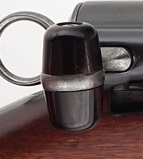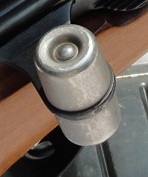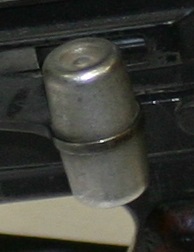Identifying guns is a bit like learning a language. Once you understand enough different words, you become able to decipher the meanings of brand new ones by breaking down the syllables, figuring out their basic meanings, and then reconstructing the word. Well, once you’ve seen enough guns you start to be able to recognize characteristics and features to the point that you can make pretty good educated guesses about the lineage of weapons you may never have laid eyes on before.
Some of these characteristics are basic mechanical features, like open-bottomed magazine housing indicating Mannlicher-type clip use (Carcano, Dutch Mannlicher, Berthier, Steyr-Mannlicher, etc). Others are semifunctional design decisions, like the open-topped slides used on Beretta pistols for decades (models 1915/19/23, 1934/35, 1951, Cheetah, 92/96, and more). And some are fully aesthetic elements that a particular nation or factory has decided to keep around. A good example of that is the distinctive beer-keg charging handle used on Swiss rifles for about 70 years, from the Model 1889 to the StG57:
In fact, it was that charging handle that clued me in to the identity of that Bern prototype the first time I saw it…





Another good example would be the scalloped barrels on British military revolvers such as the Webley and Enfield.
Good call, Jameszb! I read up on the intertwined design histories of the two marques ( as far as wartime military revolvers go ), and it was quite fascinating to see the thrust-and-parry between Webley & Scott on the one hand, and the UK Government via RSAF Enfield on the other.
I’m curious…Were you able to determine why they preferred that style of barrel? I have assumed it either had to do with ease of manufacture or possibly that the scalloped design was less susceptible to being bent.
Quote : “Additionally, viewing a firearm as an assemblage of components instead of always as an entirety adds a level of intellect and distinction to any relevant conversation”.
Well said, D. Hide! In some ways, a close parallel to the idea that a gun is only as good as the sum of its parts, with expansion in both directions of the thought process ( a weapon system seen from the points of view of its overall function and influence on the social, economic, political and military aspects, and of its capabilities due to the mechanical interactions of its components ).
I certainly agree about your assessment of the political scene — too many self-serving issues and causes on both sides ( and everything else in between, I might add ) that tend to muddy the real issues and obfuscate the truth.
Sorry, this is what comes of typing too fast at the end of a long work day — this reply was meant for D. Hide, but to be shared by all as always. And I’ve got to watch my fingers on the keyboard — It should read as “Earl Liew, not “Earl Liewa”!
Sincerest apologies to all for any confusion and misunderstanding this might have caused.
Hi, Jamezb :
I think you may have already hit the nail on the head. As far as I know, the scalloped barrel design served two purposes, that of stiffening and strengthening the barrel longitudinally against bending forces while removing “excess” material and reducing weight, and of providing a ( coincidentally ) more aesthetic profile.
As for ease of manufacture, I would have thought that a symmetrically-rounded barrel profile would have been least demanding on the manufacturing process ; however, I am perfectly willing to concede that other precedents affecting this process — such as prior and existing tooling set-ups, detailed material and weight removal related to the overall balance and feel of the gun, and even something as apparently mundane as adherance to traditional or preferred appearances, among many possibilities — could have been a factor.
Perhaps other more knowledgeable FW contributors than I would have a satisfactory answer to this question?
Didnt the “Beer Keg” technically start out as a bolt handle and then becuame a charging handle once it was applied to a semi-automatic rifle?
Yep. All of Switzerland’s straight-pull rifles (except the briefly-used and unpopular license-built Mannlicher carbine) used that style of bolt handle. Up until the K31, they used Bakelite, then they went to an all-metal handle. Probably because by that point they were having the Bakelite chip and break off on some of their older rifles.
The more you know. the more you know, you dont know
Which is why we have FW so that we can continue to learn from one another, and also contribute to the knowledge pool. And making friends in the process doesn’t hurt either.
Was just thinking about this the other day. I was coming from a perspective of how to teach someone to recognize patterns in firearms and be able to identify at the very least that something is different to another thing. I think a lot of laypersons confuse some firearms for another that are almost nothing alike. Additionally, viewing a firearm as an assemblage of components instead of always as an entire entity adds a level of intellect and distinction to any relevant conversation. Hopefully, this works to quell the generalizations we so often hear that unnecessarily bring down the level of the discussion – Say, in the political scene which is notorious for being brainless in its execution.
Slightly off topic if that’s OK ; )
When I was in the Army (British) sometimes we found Terrorist weapons hidden and they where usually wrapped in plastic, so you couldn’t see what they were. If we were going to leave them in the hide so we could ambush the Terrorists who came to collect them, we would have to find out what each weapon was by feel.
Enough waffle from me.
Simon_the_Brit